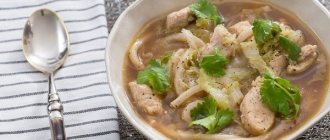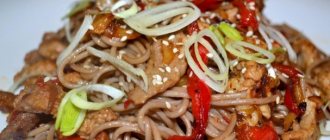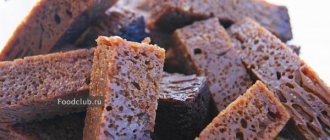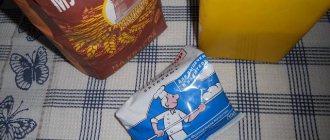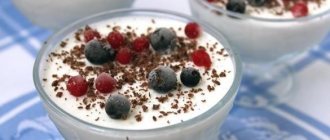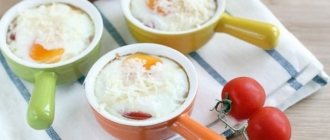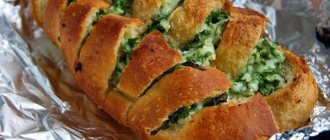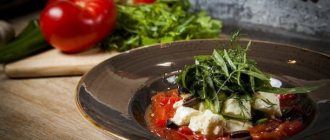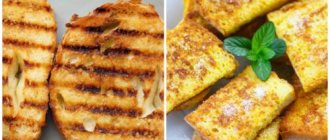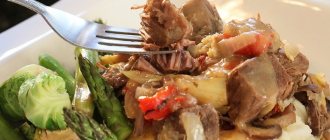Hi all!
Today I want to introduce you to another Asian dish. No, this is not sashimi or sushi, but noodles. Japan, the land of the rising sun, is famous for its exquisite cooking, which uses products not only raw, but also boiled.
We will not talk here about the product that is sold on the shelves of our supermarkets with the inscription “Instant cooking”. Your body is unlikely to get anything from it other than empty calories and harmful additives.
Thanks to this article, you will learn what udon noodles are and how to cook them correctly at home, what dishes you can make with them, what they consist of, whether they are good for health, and much more interesting things.
Types of Udon Noodles
In Japan, whose quality standards are considered benchmarks, there is a clear classification of all types of noodles, which indicates their parameters (width and thickness) and names. All types of noodles are numbered from 1 to 30, the higher the number, the thinner the noodles.
The thickest Udon noodles are number 7. They do not have their own name. Its width is 4.29 mm and thickness 3.21 mm.
Udon noodles No. 8 also have no name, its width is 3.75 mm and thickness 2.81 mm.
Udon noodles No. 9 is also unnamed, its width is 3.33 mm and thickness 2.50 mm.
Udon noodles No. 10 are 3.00 mm wide and 2.25 mm thick. It is used in the Okinawa soba dish (沖縄そば, rH. Okinawasoba) as a substitute for Soba noodles. This is a noodle dish seasoned with broth.
Udon noodles No. 12 are 2.50 mm wide and 1.88 mm thick. It is used in Okinawa Soba (沖縄そば, rH. Okinawasoba) or Kitakata Ramen (Japanese 喜多方ラーメン, rH. Kitakata ramen) as a substitute for Soba or Ramen noodles, respectively.
Udon noodles No. 14 are 2.14 mm wide and 1.61 mm thick. It is used in broth noodles Sano ramen (Japanese: さのラーメン, rH. Sano ramen) or Kitakata Ramen (Japanese: 喜多方ラーメン, rH. Kitakata ramen) as a replacement for Ramen noodles.
Udon noodles No. 15 without name, its width is 2.00 mm and thickness is 1.50 mm.
Udon noodles No. 16, its width is 1.88 mm and thickness 1.41 mm. It is used in noodles with Shirakawa ramen broth (しらかわラーメン, rH. Shirakawa ramen) or Champon (ちゃんぽん, rH. Chanpon).
Udon in Japanese cuisine
In Japan, Udon noodles are sold in several types.
Chilled noodles (Japanese: チルド麺, rH. Chirudo men) – fresh noodles that have already been boiled. Sold chilled, rolled into a ball or ball, usually 1 serving. This is why they are also called “udon balls”. Ready-to-use product. You can pour broth or fry. Or reheat and add sauce.
Raw Udon (生うどん, rH. Nama udon) is also fresh Udon noodles, but not yet cooked. The freshest product, with excellent taste, but does not last long. It goes on sale in vacuum packaging.
Half-raw Udon (Japanese: 半生うどん, rH. Hansei udon) is a condition of noodles in which the moisture content is no more than 33%. These are not dried noodles, but they are not boiled either. Semifinished. Can be stored longer than raw Udon.
Dried Udon (Japanese: 干しうどん, rH. Hoshi udon) is a familiar noodle that is sold in stores. It can be stored for a long time; before eating, the noodles need to be boiled for 3-4 minutes.
Frozen Udon (冷凍うどん, rH. Reitō udon) - This option involves boiling the noodles and then freezing them. The product must be thawed before use.
Instant noodles (Japanese 油揚げ麺, rH. Aburaage men) are freeze-dried noodles familiar to Doshirak lovers. Added the sauce and poured boiling water over it.
The most popular traditional Japanese noodle dishes are:
- Kare-udon or Udon with curry (Japanese: カレーうどん, rH. Karē udon) - boiled noodles are generously seasoned with curry sauce, meat and vegetables are added as toppings.
- Kitsune udon (Japanese: きつねうどん, rH. Kitsune udon) - hot boiled Udon noodles in broth (or without it) with aburaage (heavily fried tofu).
- Kake soba (Japanese: かけうどん, rH. Kake udon) - hot Udon in broth, sprinkled with chopped shallots and garnished (optional) with a piece of kamaboko (something like fish sticks).
- Nabe yakiudon (Japanese: 鍋焼きうどん, rH. Nabe yakiudon) - Udon noodles are cooked in a special pot along with seafood. Popular toppings for this dish include shrimp tempura, shiitake mushrooms and eggs.
- Sutamina udon (Japanese: スタミナうどん, rH. Sutamina udon) - or, as it is also called, “nutritious noodles” - is believed to help restore vitality. Meat, raw eggs and vegetables are served as toppings for the noodles.
- Tempura udon (Japanese: 天ぷらうどん, rH. Tempura udon) – hot Udon noodles in broth with tempura shrimp.
- Tsukimi udon (Japanese 月見うどん, rH. Tsukimi udon) - a pile of hot Udon noodles with hot broth is crowned with a poached egg boiled in broth.
- Yaki udon (Japanese: 焼きうどん, rH. Yaki udon) – traditional Japanese fried noodles with seafood and vegetables, generously seasoned with sauce. This is a variation of the popular Japanese dish Yakisoba (焼きそば, rH. Yakisoba), using Udon instead of Ramen noodles.
- Champon (Japanese: ちゃんぽん, rH. Chanpon) – hot noodles in meat broth; fried meat (or seafood) is added to the soup. The noodles are cooked directly in the broth. The soup is seasoned with spicy seasonings.
What are udon noodles? Let's talk about an unfamiliar dish
Origin story
Udon, along with rice, is the national dish of the land of the rising sun - Japan. But the history of its appearance is connected with a completely different state - China. The invention of the dish is attributed to a Chinese monk who was trying to find light ingredients that excluded animal fats.
And he, in turn, has already brought the recipe to Japan. Although noodles gained popularity in this country only several centuries later, in the 17th-19th centuries during the Edo era. They began to add meat, vegetables and many other more nutritious foods to it. Serve with sauces, sprouts and mushrooms.
Did you know that the word “udon” comes from the Chinese “wonton”, which means dumplings or dumplings.
What is usually included
Udon is a long, white and dense noodle that is traditionally made by mixing light wheat flour, water and salt. When eating food, the Japanese usually tear it into pieces. It is quite soft and chewy, with a neutral flavor that makes it an ideal side dish for spicier dishes.
Udon is the thickest Japanese noodle with a diameter of 2 to 4 mm. It can be enjoyed both hot and cold. In the first case, it is served with a soup made of soy sauce, fish stock and mirin (sweet rice wine), although the ingredients may vary depending on the region. In stores you can buy noodles in fresh, dried and frozen forms.
The best is, of course, fresh. If it is not available, it is better to purchase frozen, but during cooking it should not be fried or overcooked. The dried product is much thinner and shorter, and will not have that soft and pleasant consistency.
Udon in Chinese cuisine
In Chinese cuisine, Udon wheat noodles are called Wu Dong Mian (Chinese: 乌冬面, pinyin Wu Dong Mian) - they are made, just like in Japan, from wheat flour, salt and water (wrappers are made from the same dough for wontons).
By the way, it was the pronunciation of the word “wonton” in the Cantonese dialect that gave the name to Udon noodles. In the Middle Kingdom, Udon noodles are often fried; this is more consistent with local culinary traditions. Fried Udon dishes are similar to the popular fried noodle dish Chow Mein (Chinese: 炒面, Pinyin Shaomian). All kinds of toppings are added to the noodles - meat (including poultry and offal), seafood and fish, vegetables (including leafy ones), mushrooms, tofu, etc. etc., and seasoned with various sauces, of which there are a great many in the Celestial Empire. These include salty, sweet, sweet and sour, and hot sauces. In general, the cook’s imagination is limited only by the availability of food in the refrigerator.
Noodles with broth are prepared according to recipes adopted from Japanese cuisine and adapted to Chinese traditions.
Udon wheat noodles: benefits for the body
- improves skin color and structure;
- strengthens hair and nails;
- slows down the aging process;
- strengthens the nervous system;
- restore strength;
- increases resistance to infections;
- reduces the risk of developing heart and vascular diseases.
Udon is wheat noodles that has all the beneficial properties characteristic of Japanese cuisine. Due to the high content of B vitamins, this product is considered beneficial for the immune, nervous, endocrine, and musculoskeletal systems. The product is good for improving performance, recovery after exercise and stress.
Udon in Korean cuisine
Udon noodles are also used in Korea. Udon noodle soup is called Udong (Korean: 우동), from the Japanese transliteration "udon". The noodles themselves are called udon myeon (Korean: 우동면), and these noodles are considered garak guksu (Korean: 가락국수) or “thick noodles.”
Its main consumers are Chinese ethnic communities in Korea. Dishes that are prepared in Korea with Udon noodles either came to Korea during the Japanese occupation, or are dishes of Chinese Korean cuisine. Udon noodles in Korea are the most popular in street fast food - so to speak, Japanese noodles in Korean style. These noodles can be enjoyed at numerous eateries, called Bunsik (Korean: 분식) in Korea, or at street stalls or Rojanmachha (Korean: 포장마차) carts in South Korea. Udon can be enjoyed in numerous Japanese restaurants.
The most popular Udon noodle dishes in Korean cuisine are:
- Champong (Korean: 짬뽕) is a spicy soup with noodles, vegetables and meat (or seafood). This dish came to Korea from Shandong cuisine (PRC) and is popular in Korea and Japan.
- Jajangmyeon (Korean: 자장면) is a dish of Udon noodles, generously seasoned with a sauce based on Chungjang (Korean: 춘장) black bean paste, as well as diced pork (optional, seafood) and vegetables.
Udon noodles. Udon (うどん)
Udon (don どん) are thick Japanese noodles made from wheat flour. The noodles are thicker than soba noodles, white and softer. Udon is widely available in restaurants throughout Japan and is prepared in a variety of hot and cold dishes.
CONTENT
Popular dishes Udon
Below is a list of udon dishes that tourists commonly find in restaurants throughout Japan. Please note that there are some regional differences in terms of name and seasoning.
Zaru Udon (cold)
Zaru Udon noodles are cooled and served on a bamboo mat. It is served with a dipping sauce and is dipped into the sauce before eating. It is very similar to Zaru Soba, the only difference being that it is a different type of noodle.
Cake Udon (hot)
Kake Udon is a basic udon dish served in a hot broth covering the noodles. It has no filling and is usually garnished only with green onions. Kake Udon is also known as Su Udon in the Osaka region.
Kamaage Udon (hot)
Kamaage Udon noodles are served in hot water accompanied by various seasonings and dipping sauce. Some places have individual servings of Kamaage Udon in small wooden bowls, while others serve family-sized portions of Kamaage Udon in large communal wooden noodle bowls.
Tanuki Udon (hot/cold)
Tanuki udon is served in a hot broth with leftover deep-fried tempura batter (tenkasu). Tanuki udon is not usually served in Osaka, as tenkasu is often free at local udon restaurants.
Kitsune Udon (hot/cold)
Kitsune Udon is served in a hot broth with aburage, thin sheets of fried tofu placed on top of udon noodles.
Tsukimi Udon (hot)
Tsukimi Udon ("Moonlight Udon Review"), like its soba, has a raw egg on top of the udon noodles, which is meant to resemble the moon.
Tempura Udon (hot/cold)
Tempura Udon is usually served in a hot broth with pieces of tempura placed on top of the noodles. Sometimes the tempura is placed on a separate dish next to the bowl or tray of noodles. Tempura ingredients vary between seasons and stores.
Curry udon (hot)
Curry Udon - Udon noodles served in a bowl of Japanese curry. This is a popular dish in winter because it is very warm. Because eating udon curry can get confusing, some restaurants offer disposable bibs. When not offered, please be careful when eating curry udon as the udon noodles tend to splatter curry onto the clothes of those around you.
Chikara Udon (hot)
Chikara udon is udon noodles served with rice cake (mochi) added to the hot broth. The Japanese word "chikara", meaning "strength", is used as it is believed that adding mochi to a dish gives strength to the person who eats it.
Nabeyaki Udon (hot)
Nabeyaki Udon is a dish that is cooked and served in a hot pot (nabe). Udon noodles are cooked directly in the nabe along with broth and vegetables. Tempura is a common addition before serving, but more typical ingredients include mushrooms, egg, kamaboko (pink and white steamed fish cake) and various vegetables. Many stores will only serve this dish during the colder months of the year.
Where to eat udon
Udon can be found throughout Japan on menus at specialty udon restaurants (udon-ya) and soba restaurants (soba-ya), casual restaurants such as mom-and-pop restaurants, izakayas, and eateries around tourist sites. There are also several popular inexpensive udon restaurant chains with outlets in major cities and along national routes.
Washing the starch off freshly cooked udon
A regular udon dish at a regular restaurant usually costs between 500 yen and 1,000 yen, but inexpensive udon chains often sell the meal for 500 yen. At more upscale eateries or more complex udon dishes, expect to pay between 1,000 yen and 1,500 yen per person.
Noodle restaurant
In some busy train stations, you can find worthwhile udon restaurants for a quick meal between train journeys.
Some of the inexpensive udon chains operate similar to the cafeteria line. Upon entering the dining area, customers pick up a tray, order a dish from the staff behind the counter, and then choose possible side dishes such as tempura, rice balls or oden (stewed vegetables) before moving to the cash register at the end of the counter.
How to eat udon
Depending on how your udon is served, the feeding method varies. When udon is served with dipping sauce , take a few strands of noodles and dip them into the sauce before eating.
Udon, served in soup or sauce , is eaten with chopsticks, making a hollow sound when sucked. Slurping improves flavor and helps cool the hot noodles as they enter your mouth. If there is broth, it is drunk directly from the bowl, eliminating the need for a spoon. It is not considered rude to leave uneaten soup in the bowl at the end of a meal.
Regional varieties
Udon is popular throughout Japan. Below is a list of some of the most common regional varieties:
Sanuki Udon
Named after the former province that is currently Kagawa Prefecture. Sanuki Udon is the most famous variety of udon in Japan. The noodles are firm and chewy and can be eaten in a variety of ways. Udon is a very popular and cheap food in Kagawa Prefecture. Many of the nationwide udon chains serve Sanuki Udon.
Mizusawa Udon
Traditionally handcrafted from local wheat flour and spring water from Mount Mizusawa. Mizusawa Udon has a long history of feeding pilgrims heading to Mizusawa Shrine near Ikaho Onsen. Mizusawa udon is usually served chilled with either soy sauce or sesame sauce, sometimes both.
Inaniwa Udon
With a history of over 300 years, the process of making Inaniwa Udon takes about four days as it is all done by hand. After kneading the dough by hand, it is wrapped around two rods, flattened, then stretched, and finally air dried. The handcrafted result is Inaniwa Udon noodles, which are thinner than regular Udon noodles and have a smooth texture.
Ise Udon
The specialty of Ise udon is the rich and dark sauce (tsuyu) that is poured on top of the udon noodles. This rich and dark tsuyu is made from dried seaweed or smoked fish (usually mackerel or small sardines) and soy sauce. Udon noodles are typically topped with green onions and katsuobushi (smoked mackerel flakes).
Khoto
Hoto noodles are flatter and wider than regular udon noodles. They are usually cooked in a hot cast iron pan with lots of vegetables in a miso based soup. The vegetables that go to Khoto are mainly seasonal vegetables, including pumpkin.
Kishimen
Kishimen, in particular for Nagoya, are flat and thin udon noodles similar to the shape of fettuccine. The ingredients that go into making kishimen are no different from udon noodles, the main difference being the shape and time taken to prepare the noodles.
Misonikomi
Misonikomi udon is another recipe from Nagoya. This is a very rich dish, especially popular in winter. Red miso is used for the soup. Other typical ingredients include chicken, green onions, mushrooms, a raw egg on top, and rice cakes (mochi).
Okinawa Soba
While called soba, Okinawa soba are made not from buckwheat flour, but from wheat flour. Their texture is more similar to ramen and udon noodles. Okinawa soba is usually served in a hot pork broth with pork slices, green onions and pickled ginger.
Views: 1,519
Share link:
- Tweet
- Share posts on Tumblr
- Telegram
- More
- by email
- Seal
Liked this:
Like
